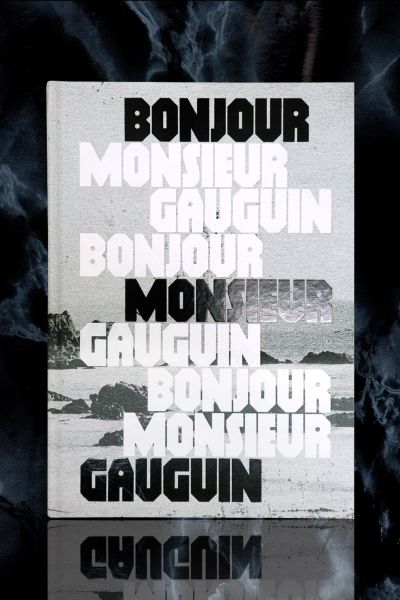Anna Pravdová
Bonjour, Monsieur, Gauguin
- Kategorie
- Bronze Medal
Begründung der Jury
★★
Czech Republic /// Tschechien
★★
Strong contrasts from matt white and glossy black embossed, thick capitals create a striking cover. The words of the book’s title are stacked on top of each other three times. Small dot-like holes punched into the letters lend ornamental accents to their chunkily edged contours, behind which the austere Brittany coastal landscape spreads out in a historical black-and white photograph: this exhibition catalogue on Czech artists in Brittany between 1850 and 1950 documents the cultural connections between eastern and western Europe. On the inside, a series of pages with historical photographs — landscapes, harbours, people — on earthy brown paper prepares the reader for the book’s content. Similar sections in the middle of the book and at the end maintain this atmosphere. It is unusual that the essay texts are only printed on the right-hand pages, and only these have been given page numbers. On the image pages — well-structured and varied, orientation is provided by the picture numbering. In order to differentiate between image references and notes in the text, hairline frames with the height of a capital letter have been added: these are noticeable without being distracting. The block-like aura is also expressed in the book’s edge, meticulously narrow and produced by the skilled bookbinding. It clarifies that the missing headband is not an error, but rather intentional design that aims to avoid watering down the block quality generated by the straight spine.
★★
Mit starken Kontrasten erzielen mattweiß und glänzend schwarz geprägte, mächtige Versallettern einen plakativen Einband. Wort für Wort stapelt sich der Buchtitel in kompressen Zeilen dreifach übereinander. Klobig gekantete Buchstabenkonturen erhalten durch kleine punktförmige Punzen ornamentale Akzente. Dahinter breitet sich auf der ganzen Buchdecke die herbe bretonische Küstenlandschaft in einem historischen Schwarzweißfoto aus: Der Ausstellungskatalog über tschechische Künstler in der Bretagne 1850–1950 dokumentiert die kulturellen Verbindungen zwischen Ost- und Westeuropa. Innen stimmt eine Seitenfolge historischer Fotografien – Landschaft, Hafen, Menschen – auf erdig braunem Papier auf den Inhalt ein. Gleichartige Teile in der Buchmitte und zum Ausklang halten diese Atmosphäre aufrecht. Ungewöhnlicherweise stehen die Aufsatztexte nur auf rechten Seiten, auch nur diese sind paginiert. Die Bildseiten – wohlgeordnet und abwechslungsreich zugleich – gewähren Orientierung durch die Abbildungsnummerierung. Um im Text die Bildverweise von den Anmerkungsnummern zu unterscheiden, werden sie in einen versalhohen, haarlinienfeinen Rahmen gestellt: Das fallt auf, ohne ins Auge zu stechen. Das Blockhafte kommt auch durch die sorgfältig knappe Stehkante der buchbinderischen Verarbeitung zum Ausdruck. Dann wird auch klar, dass das Fehlen des Kapitalbändchens kein Versäumnis ist, sondern eine gestalterische Entscheidung, um das Blockige des geraden Ruckens nicht abzumildern.

